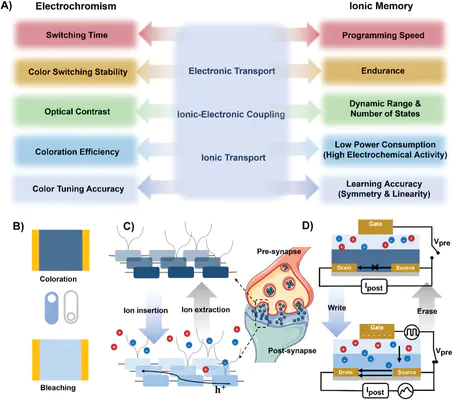Unraveling Polymer–Ion Interactions in Electrochromic Polymers for their Implementation in Organic Electrochemical Synaptic Devices

Abstract
Owing to low-power, fast and highly adaptive operability, as well as scalability, electrochemical random-access memory (ECRAM) technology is one of the most promising approaches for neuromorphic computing based on artificial neural networks. Despite recent advances, practical implementation of ECRAMs remains challenging due to several limitations including high write noise, asymmetric weight updates, and insufficient dynamic ranges. Here, inspired by similarities in structural and functional requirements between electrochromic devices and ECRAMs, we demonstrate high-performance, single-transistor and neuromorphic devices based on electrochromic polymers (ECPs). To effectively translate electrochromism into electrochemical ion memory in polymers, we systematically investigate ion-polymer interaction, redox activity, mixed ionic-electronic conduction, and stability of ECPs both experimentally and computationally using select electrolytes. The best-performing ECP-electrolyte combination is then implemented into an ECRAM device to further explore synaptic plasticity behaviors. The resulting ECRAM exhibits high linearity and symmetric conductance modulation, high dynamic range (~1 mS or ~6x), and high training accuracy (> 84% within 5 training cycles on a standard image recognition dataset), comparable to existing state-of-the-art ECRAMs. This work offers a promising approach to discover and design novel polymer materials for organic ECRAMs and demonstrates potential applications, taking advantage of mature knowledge basis on electrochromic materials and devices.